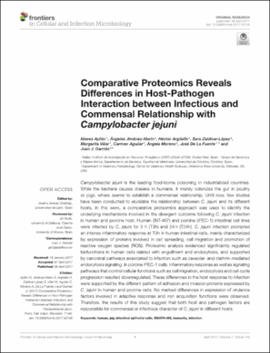| dc.contributor.author | Ayllon, Nieves | |
| dc.contributor.author | Jimenez-Marin, Angeles | |
| dc.contributor.author | Arguello, Hector | |
| dc.contributor.author | Zaldivar-Lopez, Sara | |
| dc.contributor.author | Villar, Margarita | |
| dc.contributor.author | Aguilar, Carmen | |
| dc.contributor.author | Moreno, Angela | |
| dc.contributor.author | de la Fuente, Jose | |
| dc.contributor.author | Garrido, Juan J. | |
| dc.date.accessioned | 2019-08-28T16:00:49Z | |
| dc.date.available | 2019-08-28T16:00:49Z | |
| dc.date.issued | 2017-04-26 | |
| dc.identifier | oksd_ayllon_comparativeprot_2017 | |
| dc.identifier.citation | Ayllon, N., Jimenez-Marin, A., Arguello, H., Zaldivar-Lopez, S., Villar, M., Aguilar, C., ... Garrido, J. J. (2017). Comparative proteomics reveals differences in host-pathogen interaction between infectious and commensal relationship with Campylobacter jejuni. Frontiers in Cellular and Infection Microbiology, 7, Article 145. https://doi.org/10.3389/fcimb.2017.00145 | |
| dc.identifier.uri | https://hdl.handle.net/11244/321374 | |
| dc.description.abstract | Campylobacter jejuni is the leading food-borne poisoning in industrialized countries. While the bacteria causes disease in humans, it merely colonizes the gut in poultry or pigs, where seems to establish a commensal relationship. Until now, few studies have been conducted to elucidate the relationship between C. jejuni and its different hosts. In this work, a comparative proteomics approach was used to identify the underlying mechanisms involved in the divergent outcome following C. jejuni infection in human and porcine host. Human (INT-407) and porcine (IPEC-1) intestinal cell lines were infected by C. jejuni for 3 h (T3h) and 24 h (T24h). C. jejuni infection prompted an intense inflammatory response at T3h in human intestinal cells, mainly characterized by expression of proteins involved in cell spreading, cell migration and promotion of reactive oxygen species (ROS). Proteomic analysis evidenced significantly regulated biofunctions in human cells related with engulfment and endocytosis, and supported by canonical pathways associated to infection such as caveolar- and clathrin-mediated endocytosis signaling. In porcine IPEC-1 cells, inflammatory response as well as signaling pathways that control cellular functions such as cell migration, endocytosis and cell cycle progression resulted downregulated. These differences in the host response to infection were supported by the different pattern of adhesion and invasion proteins expressed by C. jejuni in human and porcine cells. No marked differences in expression of virulence factors involved in adaptive response and iron acquisition functions were observed. Therefore, the results of this study suggest that both host and pathogen factors are responsible for commensal or infectious character of C. jejuni in different hosts. | |
| dc.format | application/pdf | |
| dc.language | en_US | |
| dc.publisher | Frontiers Media | |
| dc.rights | This material has been previously published. In the Oklahoma State University Library's institutional repository this version is made available through the open access principles and the terms of agreement/consent between the author(s) and the publisher. The permission policy on the use, reproduction or distribution of the material falls under fair use for educational, scholarship, and research purposes. Contact Digital Resources and Discovery Services at lib-dls@okstate.edu or 405-744-9161 for further information. | |
| dc.title | Comparative proteomics reveals differences in host-pathogen interaction between infectious and commensal relationship with Campylobacter jejuni | |
| osu.filename | oksd_ayllon_comparativeprot_2017.pdf | |
| dc.description.peerreview | Peer reviewed | |
| dc.identifier.doi | 10.3389/fcimb.2017.00145 | |
| dc.description.department | Veterinary Pathobiology | |
| dc.type.genre | Article | |
| dc.type.material | Text | |
| dc.subject.keywords | swath-ms | |
| dc.subject.keywords | human | |
| dc.subject.keywords | immunity | |
| dc.subject.keywords | infection | |
| dc.subject.keywords | intestinal epithelial cells | |
| dc.subject.keywords | pig | |
| dc.subject.keywords | campylobacter jejuni | |
